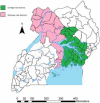Conflict of interest: use of pyrethroids and amidines against tsetse and ticks in zoonotic sleeping sickness endemic areas of Uganda
- PMID: 23841963
- PMCID: PMC3711891
- DOI: 10.1186/1756-3305-6-204
Conflict of interest: use of pyrethroids and amidines against tsetse and ticks in zoonotic sleeping sickness endemic areas of Uganda
Abstract
Background: Caused by trypanosomes and transmitted by tsetse flies, Human African Trypanosomiasis and bovine trypanosomiasis remain endemic across much of rural Uganda where the major reservoir of acute human infection is cattle. Following elimination of trypanosomes by mass trypanocidal treatment, it is crucial that farmers regularly apply pyrethroid-based insecticides to cattle to sustain parasite reductions, which also protect against tick-borne diseases. The private veterinary market is divided between products only effective against ticks (amidines) and those effective against both ticks and tsetse (pyrethroids). This study explored insecticide sales, demand and use in four districts of Uganda where mass cattle treatments have been undertaken by the 'Stamp Out Sleeping Sickness' programme.
Methods: A mixed-methods study was undertaken in Dokolo, Kaberamaido, Serere and Soroti districts of Uganda between September 2011 and February 2012. This included: focus groups in 40 villages, a livestock keeper survey (n = 495), a veterinary drug shop questionnaire (n = 74), participatory methods in six villages and numerous semi-structured interviews.
Results: Although 70.5% of livestock keepers reportedly used insecticide each month during the rainy season, due to a variety of perceptions and practices nearly half used products only effective against ticks and not tsetse. Between 640 and 740 litres of insecticide were being sold monthly, covering an average of 53.7 cattle/km(2). Sales were roughly divided between seven pyrethroid-based products and five products only effective against ticks. In the high-risk HAT district of Kaberamaido, almost double the volume of non-tsetse effective insecticide was being sold. Factors influencing insecticide choice included: disease knowledge, brand recognition, product price, half-life and mode of product action, product availability, and dissemination of information. Stakeholders considered market restriction of non-tsetse effective products the most effective way to increase pyrethroid use.
Conclusions: Conflicts of interest between veterinary business and vector control were found to constrain sleeping sickness control. While a variety of strategies could increase pyrethroid use, regulation of the insecticide market could effectively double the number of treated cattle with little cost to government, donors or farmers. Such regulation is entirely consistent with the role of the state in a privatised veterinary system and should include a mitigation strategy against the potential development of tick resistance.
Figures



Similar articles
-
Cost analysis of options for management of African Animal Trypanosomiasis using interventions targeted at cattle in Tororo District; south-eastern Uganda.Parasit Vectors. 2015 Jul 22;8:387. doi: 10.1186/s13071-015-0998-8. Parasit Vectors. 2015. PMID: 26198109 Free PMC article.
-
Sustaining Efforts of Controlling Zoonotic Sleeping Sickness in Uganda Using Trypanocidal Treatment and Spray of Cattle with Deltamethrin.Vector Borne Zoonotic Dis. 2019 Aug;19(8):613-618. doi: 10.1089/vbz.2018.2382. Epub 2019 Jan 14. Vector Borne Zoonotic Dis. 2019. PMID: 30638437
-
Impact of mass chemotherapy in domestic livestock for control of zoonotic T. b. rhodesiense human African trypanosomiasis in Eastern Uganda.Acta Trop. 2017 Jan;165:216-229. doi: 10.1016/j.actatropica.2016.08.022. Epub 2016 Aug 25. Acta Trop. 2017. PMID: 27570206
-
Chemical control of ticks on cattle and the resistance of these parasites to acaricides.Parasitology. 2004;129 Suppl:S353-66. doi: 10.1017/s0031182003004682. Parasitology. 2004. PMID: 15938518 Review.
-
Integrated control of vector-borne diseases of livestock--pyrethroids: panacea or poison?Trends Parasitol. 2003 Aug;19(8):341-5. doi: 10.1016/s1471-4922(03)00164-8. Trends Parasitol. 2003. PMID: 12901934 Review.
Cited by
-
Tackling protozoan parasites of cattle in sub-Saharan Africa.PLoS Pathog. 2021 Oct 14;17(10):e1009955. doi: 10.1371/journal.ppat.1009955. eCollection 2021 Oct. PLoS Pathog. 2021. PMID: 34648585 Free PMC article. No abstract available.
-
Farmers' knowledge, perceptions, and practices on animal trypanosomosis and the tsetse fly vector: A cross-sectional study around Kenya's Arabuko-Sokoke Forest Reserve at the livestock-wildlife interface.Open Res Afr. 2022 Jun 6;5:22. doi: 10.12688/openresafrica.13397.1. eCollection 2022. Open Res Afr. 2022. PMID: 37600566 Free PMC article.
-
Cattle movements and trypanosomes: restocking efforts and the spread of Trypanosoma brucei rhodesiense sleeping sickness in post-conflict Uganda.Parasit Vectors. 2013 Sep 27;6(1):281. doi: 10.1186/1756-3305-6-281. Parasit Vectors. 2013. PMID: 24289452 Free PMC article.
-
Emerging and reemerging neglected tropical diseases: a review of key characteristics, risk factors, and the policy and innovation environment.Clin Microbiol Rev. 2014 Oct;27(4):949-79. doi: 10.1128/CMR.00045-14. Clin Microbiol Rev. 2014. PMID: 25278579 Free PMC article. Review.
-
The importance of veterinary policy in preventing the emergence and re-emergence of zoonotic disease: examining the case of human african trypanosomiasis in Uganda.Front Public Health. 2014 Nov 3;2:218. doi: 10.3389/fpubh.2014.00218. eCollection 2014. Front Public Health. 2014. PMID: 25405148 Free PMC article.
References
-
- Swallow B. Impacts of Trypanosomiasis on African Agriculture. Rome: Food and Agriculture Organisation; 2000.
-
- Kristjanson P, Swallow B, Rowlands G, Kruska R, deLeeuw P. Measuring the costs of African animal trypanosomiasis, the potential benefits of control and returns to research. Agric Syst. 1999;59:79–98. doi: 10.1016/S0308-521X(98)00086-9. - DOI
-
- Shaw A. In: The Trypanosomiases. Maudlin I, Holmes P, Miles M, editor. Cambridge: CABI Publishing; 2004. Economics of African Trypanosomiasis; pp. 369–402.
-
- Fèvre E, Picozzi K, Jannin J, Welburn S, Maudlin I. Human African Trypanosomiasis: epidemiology and control. Adv Parasitol. 2006;61:167–221. - PubMed
Publication types
MeSH terms
Substances
LinkOut - more resources
Full Text Sources
Other Literature Sources

